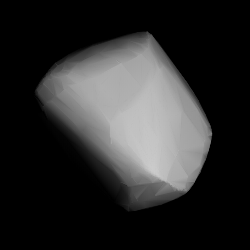1117 Reginita
Main-belt asteroid From Wikipedia, the free encyclopedia
1117 Reginita (prov. designation: 1927 KA) is a stony background asteroid from the inner regions of the asteroid belt. It was discovered on 24 May 1927, by Catalan astronomer Josep Comas i Solà at the Fabra Observatory in Barcelona, Spain, who named it after his niece.[2][1] The bright S-type asteroid has a notably short rotation period of 2.9 hours and measures approximately 10 kilometers (6.2 miles) in diameter.
 Shape model of Reginita from its lightcurve | |
| Discovery[1] | |
|---|---|
| Discovered by | J. Comas Solà |
| Discovery site | Fabra Obs. |
| Discovery date | 24 May 1927 |
| Designations | |
| (1117) Reginita | |
Named after | Reginita (discoverer's niece)[2] |
| 1927 KA · A904 TA | |
| Orbital characteristics[3] | |
| Epoch 4 September 2017 (JD 2458000.5) | |
| Uncertainty parameter 0 | |
| Observation arc | 112.47 yr (41,080 days) |
| Aphelion | 2.6934 AU |
| Perihelion | 1.8017 AU |
| 2.2475 AU | |
| Eccentricity | 0.1984 |
| 3.37 yr (1,231 days) | |
| 245.71° | |
| 0° 17m 33s / day | |
| Inclination | 4.3446° |
| 147.14° | |
| 151.05° | |
| Physical characteristics | |
| Dimensions | 9.82±2.35 km[6] 10.193±0.250 km[7][8] 10.29 km (taken)[9] 10.292 km[10] 11.22±0.35 km[11] |
| 2.928±0.0134 h[12] 2.94±0.010 h[13] 2.9458±0.0002 h[14] 2.946±0.001 h[15] 2.9463±0.0006 h[16] 2.9464±0.0005 h[17] | |
| 0.293±0.041[11] 0.3516[10] 0.3585±0.0785[8] 0.36±0.13[6] | |
| S (Tholen)[9] | |
| 11.7[1][3][11] | |
Orbit and classification
Reginita is a non-family asteroid of the main belt's background population when applying the hierarchical clustering method to its proper orbital elements.[4][5] It orbits the Sun in the inner asteroid belt at a distance of 1.8–2.7 AU once every 3 years and 4 months (1,231 days; semi-major axis of 2.25 AU). Its orbit has an eccentricity of 0.20 and an inclination of 4° with respect to the ecliptic.[3] The asteroid was first observed as A904 TA at Heidelberg Observatory in October 1904. The body's observation arc also begins at Heidelberg in April 1930, almost three years after its official discovery observation at Barcelona.[1]
Naming
This minor planet was named after the niece of the discoverer. The naming was mentioned in The Names of the Minor Planets by Paul Herget in 1955 (H 105).[2]
Physical characteristics
In the Tholen classification, Reginita is a common, stony S-type asteroid.[9]
Rotation period
Several rotational lightcurves of Reginita have been obtained from photometric observations since 1988.[12][13][14][15][16][17] The consolidated lightcurve analysis gave a rotation period of 2.946 hours with a brightness amplitude between 0.10 and 0.33 magnitude (U=3).[9]
Diameter and albedo
According to the survey carried out by the NEOWISE mission of NASA's Wide-field Infrared Survey Explorer (WISE), Reginita measures between 9.82 and 11.22 kilometers in diameter and its surface has an albedo between 0.293 and 0.36.[6][7][8][10][11] The Collaborative Asteroid Lightcurve Link adopts Petr Pravec's revised WISE data, that is, an albedo of 0.3516 and a diameter of 10.29 kilometers based on an absolute magnitude of 11.69.[9][10]
References
External links
Wikiwand - on
Seamless Wikipedia browsing. On steroids.
